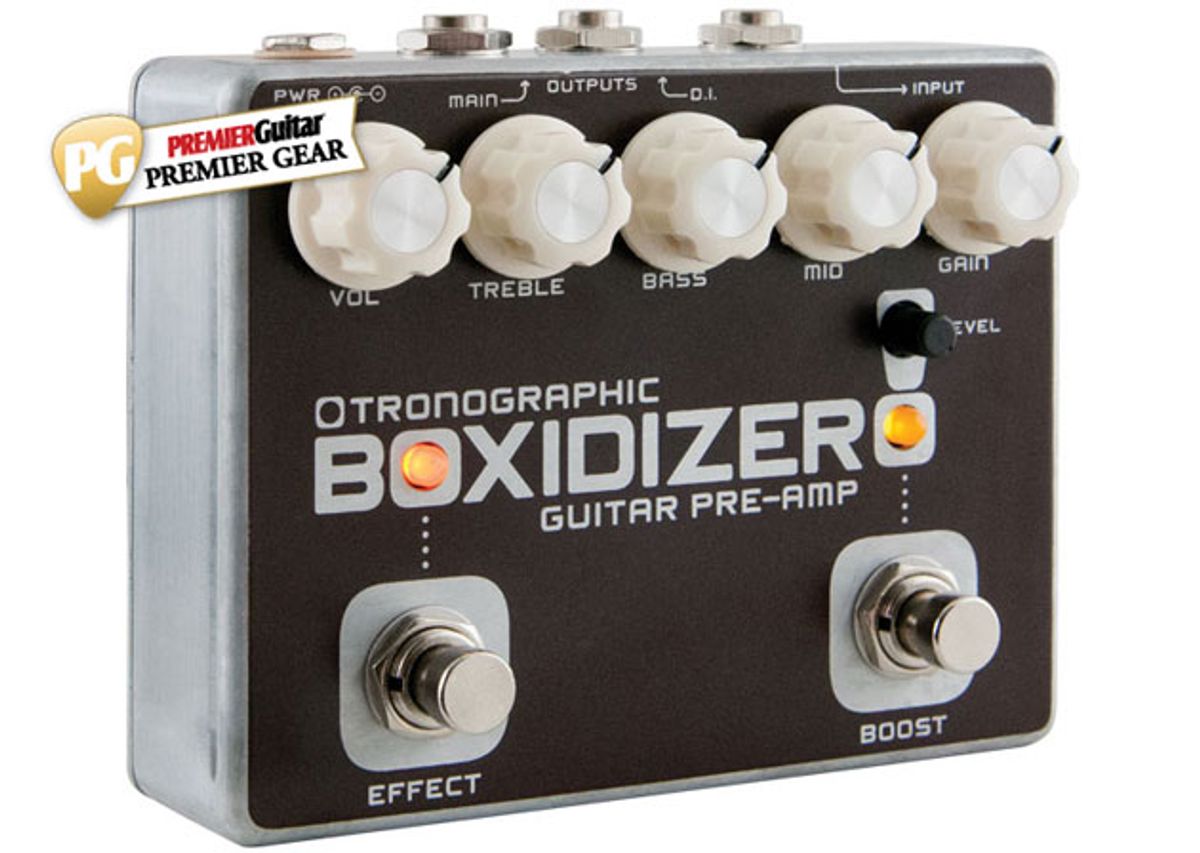
Tronographic's preamp sounds beautiful and ferocious.
With all the candy-colored fuzzes, flangers, and phasers loose in the guitar universe, adding something as pedestrian-sounding as a preamp to your stompbox array might seem a little unsexy. But consider, if you will, a session in the recording studio of your dreams. Apart from, perhaps, that old U47 mic and the vintage tube compressor over there in the rack, chances are the preamp in your chain is likeliest to elevate your sound to godlike heights. Despite their less-than-thrilling handle, preamps can be magical things.
The Tronographic Boxidizer isn’t a studio-style preamp. Tronographic says it replicates “1970s high-gain solid-state amp tone.” Yet like a nice studio preamp, the pedal lets you shape, fine-tune, fatten, flatter, and otherwise massage your guitar signal. Whether you’re looking for heftier, more precisely EQed clean tones or tighter saturation in distorted ones, the Boxidizer is a forgiving, tailorable, and easy-to-use way to add something extra to your output.
One Rock of a Box
I’m pretty sure the Boxidizer is the heaviest stompbox I’ve lifted this year—remarkable, given that it measures only 4 1/2" x 3 1/2". The enclosure itself is hefty—bulletproof even. But from the smooth knob action to the chassis-mounted I/O jacks, it’s clear the Boxidizer wasn’t built to be a wallflower. With a 3-band EQ section, input-gain control, master volume, and an independent boost control, there’s a lot going on here, yet the pedal’s tidy interior design still leaves room for a 9V battery.
The control layout is clean and logical, with treble, bass, and mid controls situated between master volume and input gain knobs. A smaller boost-level knob sits below the input gain knob at a safe distance from the boost footswitch. Another bonus is the balanced D.I. out, which lets you use the Boxidizer as a preamp directly feeding a P.A., computer audio interface, or power amp.
Clean to Mean
While the Boxidizer isn't based on a Sunn amp design (it's derived from the company's earlier Rusty Box bass pre-amp) there's a distinct “Sunn-ness,” to the way it feels and sounds, and some players will buy this pedal to get the uniquely heavy (some would say polarizing) distortion of those amps—a mainstay of stoner-rock tone. But the Boxidizer is surprisingly effective in clean, quiet settings. The master volume control has much headroom, and if you dial back the input gain almost entirely, the Boxidizer becomes a responsive and touch-sensitive clean boost. Better still, the excellent passive EQ controls have great range, which translates to even more headroom as you dial out the precise frequencies driving unwanted clipping. I used the Boxidizer extensively with a very toppy EL84-powered amp, and the pedal impressively tamed highs while adding a breadth of midrange air. (I don’t know why Tronographic doesn’t tout this side of the Boxidizer’s personality—but then, it’s unlikely that distortion devotees care much about solid-state's distortion-fighting qualities.)
Ratings
Pros:
Crushing solid-state Sunn-style distortion. Great clean boost, especially at low volume. Expansive EQ. Terrific pick sensitivity. Balanced D.I. output
Cons:
Distortion will feel brittle to some. Lead boost could be smoother.
Tones:
Ease of Use:
Build/Design:
Value:
Street:
$165
Tronographic Boxidizer
tronographic.com
When it comes to delivering the big tones most associated with '70s solid state amps, the Boxidizer steps up with muscular authority. The master volume headroom that works so well as a clean boost can drive the front end of an amp (in my case, a most un-solid state silverface Bassman) into blisteringly hot and reactive zones where pick attack becomes immediate and pronounced. Depending on your mood, your mission, and the state of your chops, the pedal cane make you feel naked and vulnerable—or like you’re firing lightning with every flick of your fingers. And if you do feel too exposed, the EQ is your friend. Rolling back highs, bumping lows, and dialing in a little midrange glow can lend a singing quality to those face-slapping dynamics.
It’s fun dialing in input gain from this relatively clean but scalding baseline. In high-gain applications, the Boxidizer mingles nicely with tube power. The distortion may sound unusual to players accustomed to the warm contours of a Marshall plexi or a blackface Fender with the volume wide open—there’s almost always a trace of hi-fi hard clipping no matter where you set the EQ. (Though putting a warm set of humbuckers and a Big Muff in the mix can wooly up tones without sacrificing the stoner-rock, wrecking-ball spirit.)
The boost function (which only works when the main effect is on) only adds to the mayhem. At high-gain settings the op amp-driven circuit often adds a touch of crackling, compressed, collapsing-upon-itself distortion. At less extreme levels, it can add sustain and presence to a lead line. The clean boost also works well as a virtual lead channel. This extra utility means some players may not need much in their line beside the Boxidizer.
The Verdict
Though Tronographic doesn’t emphasize the Boxidizer’s extreme versatility (from soft and pretty to total brutality), the pedal is remarkable for that breadth of capabilities. While the brash, leaden qualities associated with solid state amps aren’t everyone’s cup of tea, any player who likes tactile immediacy, sharp pick attack, and thick, low-mid-rich gain will love what the Boxidizer brings to even the simplest rig.


